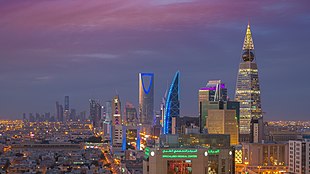This article needs additional citations for verification. (February 2022) |
 Riyadh, the financial center of Saudi Arabia | |
| Currency | Saudi Riyal (SAR)[a] |
|---|---|
| Calendar year | |
Trade organisations | WTO, OPEC, and GCC |
Country group |
|
| Statistics | |
| Population | |
| GDP | |
| GDP rank | 18th (nominal, 2024) 17th (PPP, 2024) |
GDP growth | |
GDP per capita | |
GDP per capita rank | 35th (nominal, 2024) 15th (PPP, 2024) |
GDP by sector | (2017 est.)[7]
|
| 1.6% (2024)[8] | |
| 45.9 high (2013 est.)[7] | |
| |
Labour force | 13.8 million (2017 est.)[7] |
Labour force by occupation | (2005 est.)[7]
|
| Unemployment | |
Main industries | |
| External | |
| Exports | |
Export goods | crude petroleum, refined petroleum, polymers, industrial alcohols, natural gas (2019)[7] |
Main export partners |
|
| Imports | $213.0 billion (2021 est.)[7] |
Import goods | machinery and equipment, chemicals, packaged medicine, motor vehicles, textiles, broadcasting equipment, telephones[7] |
Main import partners |
|
Gross external debt | |
| Public finances | |
| 8.9% (of GDP) (2017 est.)[7] | |
| Revenues | 310 billion (2023 est.)[7] |
| Expenses | 330.8 billion (2023 est.)[7] |
All values, unless otherwise stated, are in US dollars. | |
The economy of Saudi Arabia is the second-largest in the Middle East and the seventeenth-largest in the world.[6] The Saudi economy is highly reliant on its petroleum sector. Oil accounts on average in recent years for approximately 40% of Saudi GDP and 75% of fiscal revenue, with substantial fluctuations depending on oil prices each year.[13]
The kingdom has the second-largest proven petroleum reserves,[14] and the fourth-largest measured natural gas reserves.[15] Saudi Arabia is currently the largest exporter of petroleum in the world.[16] Other major parts of the economy include refining and chemical manufacturing from the oil reserves, much of which is vertically integrated in the state-owned enterprise, Saudi Aramco. Saudi Arabia is a permanent and founding member of OPEC.
In 2016, the Saudi government launched its Saudi Vision 2030 program to reduce its dependency on oil and diversify its economic resources.[17] By 2022, Saudi Arabia had only modestly reduced its dependence on oil.[13]
Monetary policy in Saudi Arabia is anchored by the fixed exchange rate of the Saudi Riyal to the U.S. Dollar.[18]
- ^ Strohecker, Karin (27 April 2016). "Saudi riyal peg pressure eases, but not gone". reuters.com. Reuters. Retrieved 30 September 2023.
- ^ Kirkland, Stephen (5 January 2016). "Saudi Riyal Peg Not Sustainable Amid Oil Slide, Commerzbank Says". bloomberg.com. Bloomberg L.P. Retrieved 30 September 2023.
- ^ "World Economic Outlook Database, April 2019". IMF.org. International Monetary Fund. Archived from the original on 22 December 2019. Retrieved 29 September 2019.
- ^ "World Bank Country and Lending Groups". datahelpdesk.worldbank.org. World Bank. Archived from the original on 28 October 2019. Retrieved 29 September 2019.
- ^ "GASTAT Portal". portal.saudicensus.sa. Retrieved 11 December 2023.
- ^ a b c d e f g h "World Economic Outlook Database, April 2024 Edition. (SA)". IMF.org. International Monetary Fund. 10 April 2024. Retrieved 2 May 2024.
- ^ a b c d e f g h i j k l m n o "Middle East: Saudi Arabia". cia.gov. Central Intelligence Agency. Archived from the original on 19 March 2021. Retrieved 5 March 2020.
- ^ https://www.stats.gov.sa/sites/default/files/CPI%20Mar%202024-EN.pdf Consumer Price Index, March2024
- ^ "Human Development Report 2023/2024" (PDF). United Nations Development Programme. 13 March 2024. Archived (PDF) from the original on 13 March 2024. Retrieved 15 June 2024.
- ^ "Employment to population ratio, 15+, total (%) (national estimate) – Saudi Arabia". data.worldbank.org. World Bank. Archived from the original on 31 July 2020. Retrieved 5 March 2020.
- ^ a b "Foreign trade partners of Saudi Arabia". The Observatory of Economic Complexity. Retrieved 11 May 2024.
- ^ "Monthly Statistics". www.sama.gov.sa. Archived from the original on 22 July 2021. Retrieved 24 October 2021.
- ^ a b Dept, International Monetary Fund Middle East and Central Asia (17 August 2022). "Saudi Arabia: Selected Issues". IMF Staff Country Reports. 2022 (275). doi:10.5089/9798400217548.002.A001 (inactive 1 November 2024).
{{cite journal}}: CS1 maint: DOI inactive as of November 2024 (link) - ^ "The World's Largest Oil Reserves By Country". WorldAtlas. Archived from the original on 9 May 2019. Retrieved 12 December 2018.
- ^ "Country Analysis Executive Summary: Saudi Arabia". eia.gov. Archived from the original on 13 July 2022. Retrieved 19 July 2022.
- ^ Workman, Daniel (30 November 2018). "Crude Oil Exports by Country". World's Top Exports. Archived from the original on 9 December 2018. Retrieved 12 December 2018.
- ^ Dept, International Monetary Fund Middle East and Central Asia (17 August 2022). "Saudi Arabia: Selected Issues". IMF Staff Country Reports. 2022 (275). doi:10.5089/9798400217548.002.A003 (inactive 1 November 2024).
{{cite journal}}: CS1 maint: DOI inactive as of November 2024 (link) - ^ Dept, International Monetary Fund Middle East and Central Asia (17 August 2022). "Saudi Arabia: Selected Issues". IMF Staff Country Reports. 2022 (275). doi:10.5089/9798400217548.002.A002 (inactive 1 November 2024).
{{cite journal}}: CS1 maint: DOI inactive as of November 2024 (link)
Cite error: There are <ref group=lower-alpha> tags or {{efn}} templates on this page, but the references will not show without a {{reflist|group=lower-alpha}} template or {{notelist}} template (see the help page).